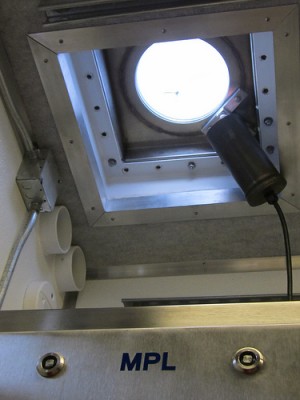Cloud Cocktail Melts Greenland Ice Sheet
Published: 3 April 2013
Like the partygoer that just won’t leave, low-level clouds hang around and cause temperatures to rise
Not all clouds are created equal—especially in the Arctic. New research published in the journal Nature shows that low-level clouds in Greenland that contain just the right amount of water are thick enough to block heat from escaping to space, but thin enough to allow sunlight to reach the surface. This cloud cocktail leads to enhanced warming near the surface. And in the summer of 2012, the paper concludes, the prevalence of these clouds caused the most melting of the Greenland Ice Sheet in over a century.

Using data obtained from a suite of sensors installed at Summit, Greenland, scientists led by Ralf Bennartz from the University of Wisconsin-Madison, David Turner of NOAA, and Matthew Shupe from the University of Colorado modeled near-surface conditions during the summer of 2012, when the Greenland Ice Sheet experienced a record-breaking melt season. Several of the instruments at Summit are from the Department of Energy’s Atmospheric Radiation Measurement (ARM) Climate Research Facility, which has operated a similar Arctic observation site in Barrow, Alaska, since 1997.
“Clouds generally play a key climate role, and ARM makes these kinds of measurements in a multitude of climate regimes,” said Jim Mather, a scientist at Pacific Northwest National Laboratory and the technical director of the ARM Facility. “Our collaboration at Summit merges some of our instruments with those provided by the project team to explore another important region.”
Detailed measurements of climate processes in Greenland and Alaska are helping scientists understand the Arctic environment and how it is changing. The instruments at Summit Station have been operating since May 2010 for a 4-year project called Integrated Characterization of Energy, Clouds, Atmospheric State, and Precipitation over Summit (ICECAPS). This project is funded through the National Science Foundation’s Arctic Observing Network and is the cover story in February’s edition of the Bulletin of the American Meteorological Society, or BAMS.
For more information:
NOAA Press Release: Thin, low Arctic clouds played an important role in the massive 2012 Greenland ice melt
ICECAPS data: http://www.archive.arm.gov/discovery/#v/results/s/s::Greenland
The ARM Climate Research Facility is a DOE Office of Science user facility. The ARM Facility is operated by nine DOE national laboratories, including .
Keep up with the Atmospheric Observer
Updates on ARM news, events, and opportunities delivered to your inbox
ARM User Profile
ARM welcomes users from all institutions and nations. A free ARM user account is needed to access ARM data.


















